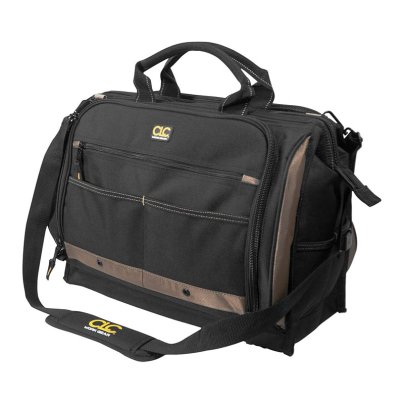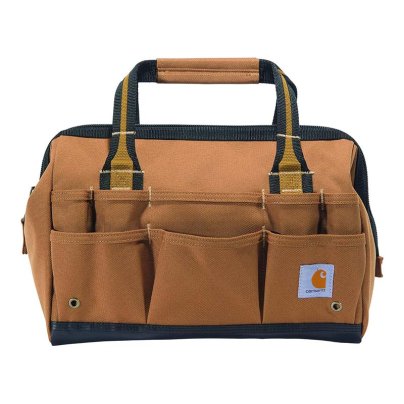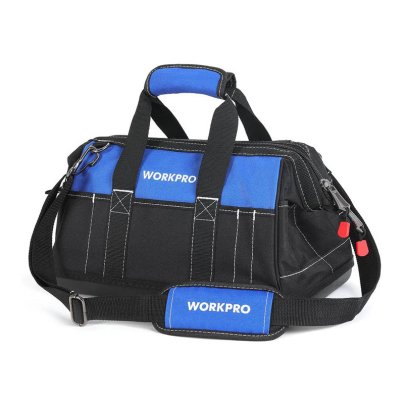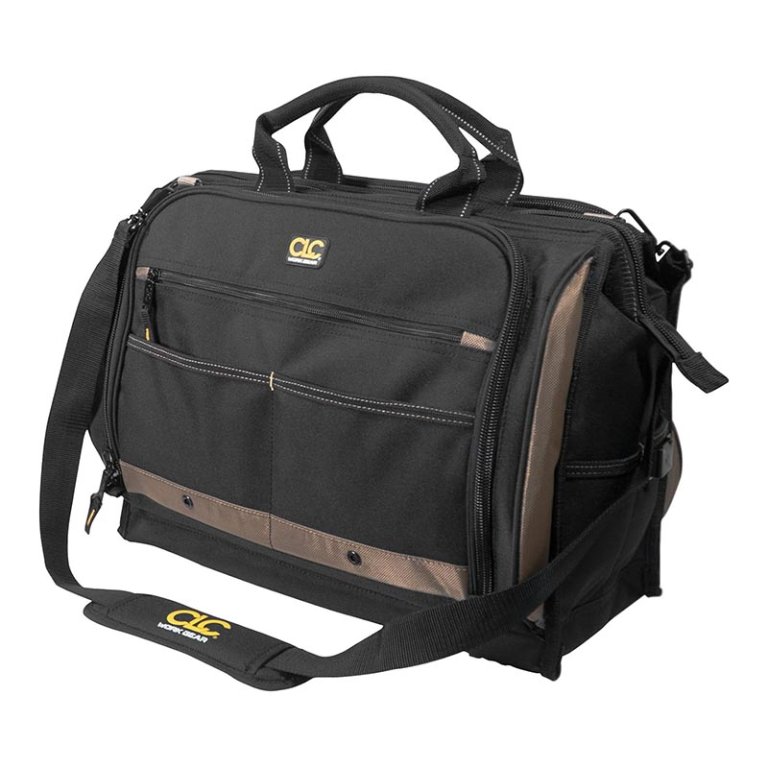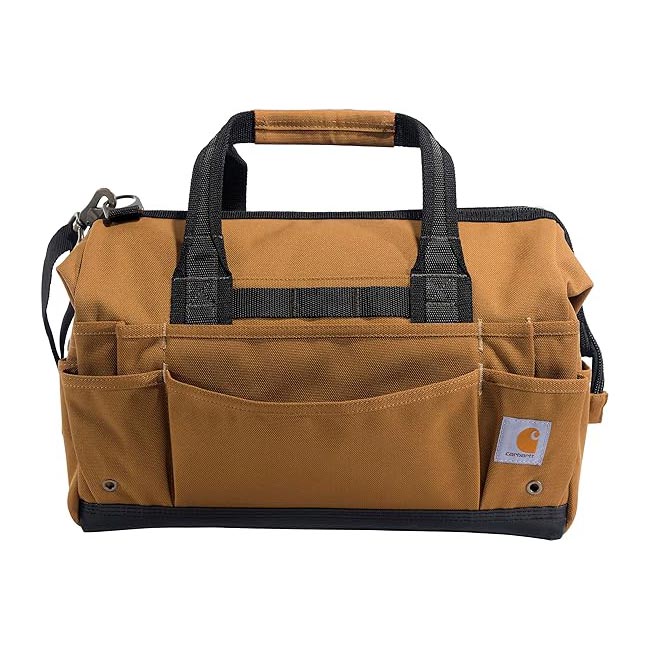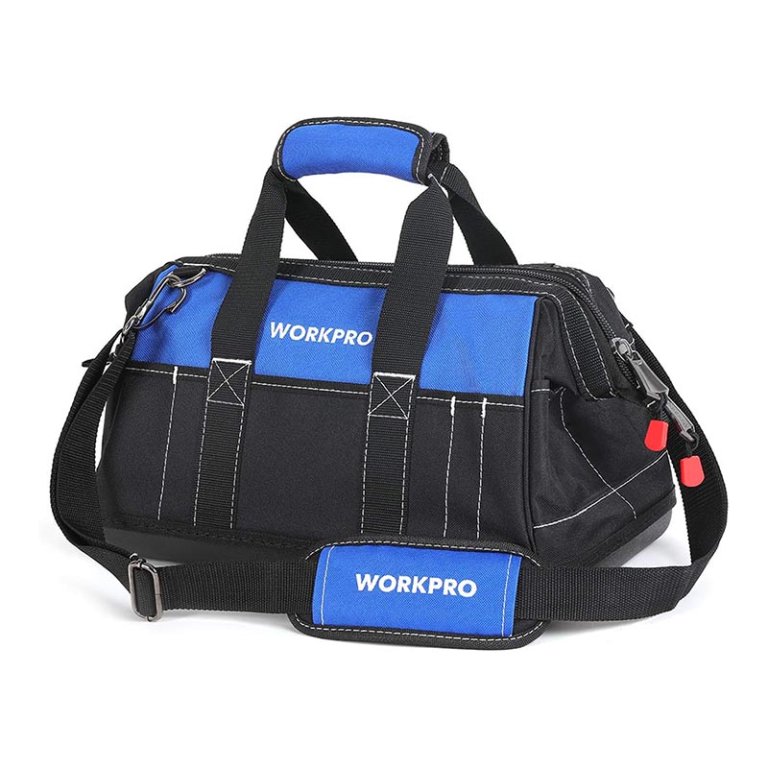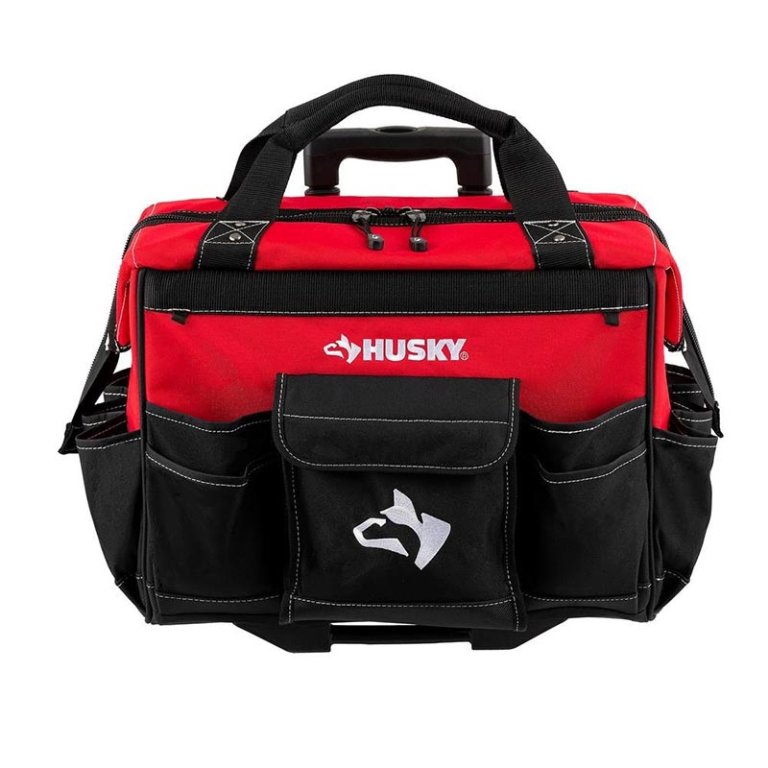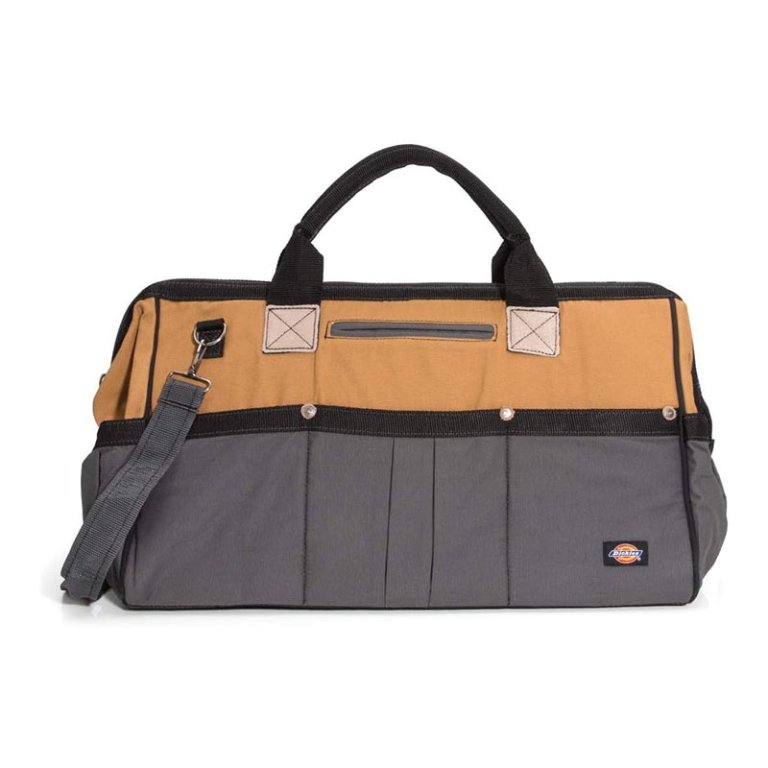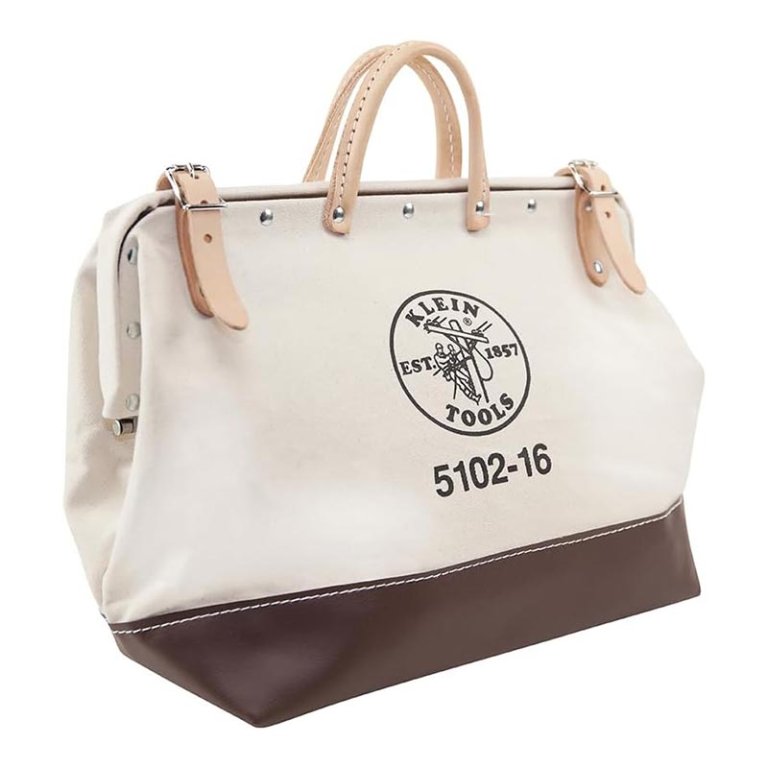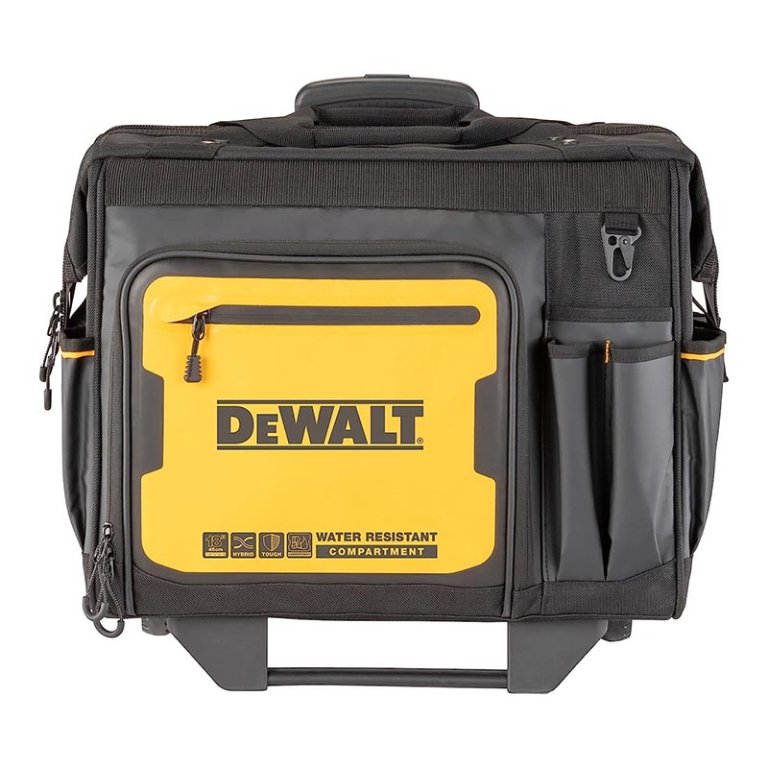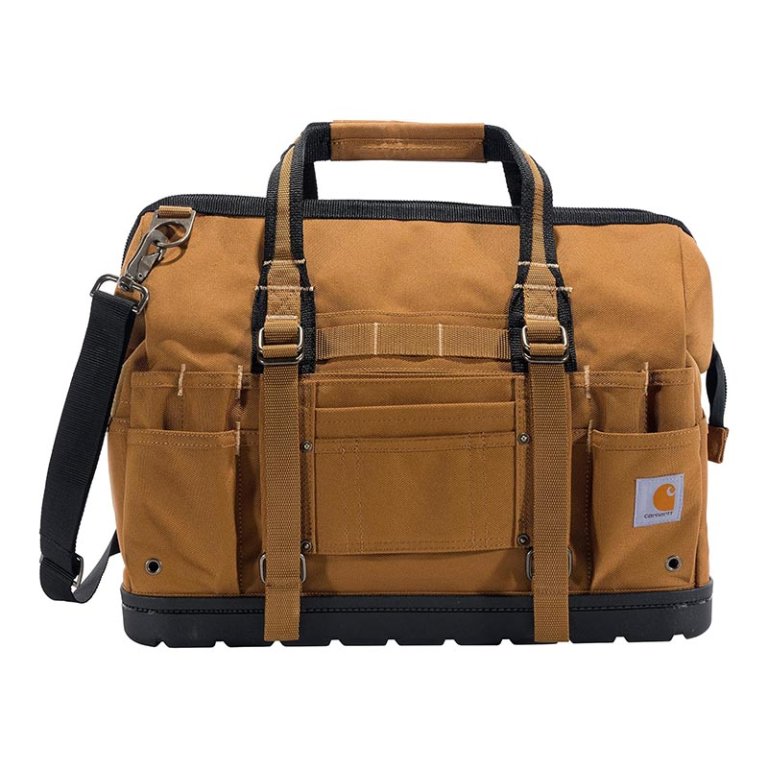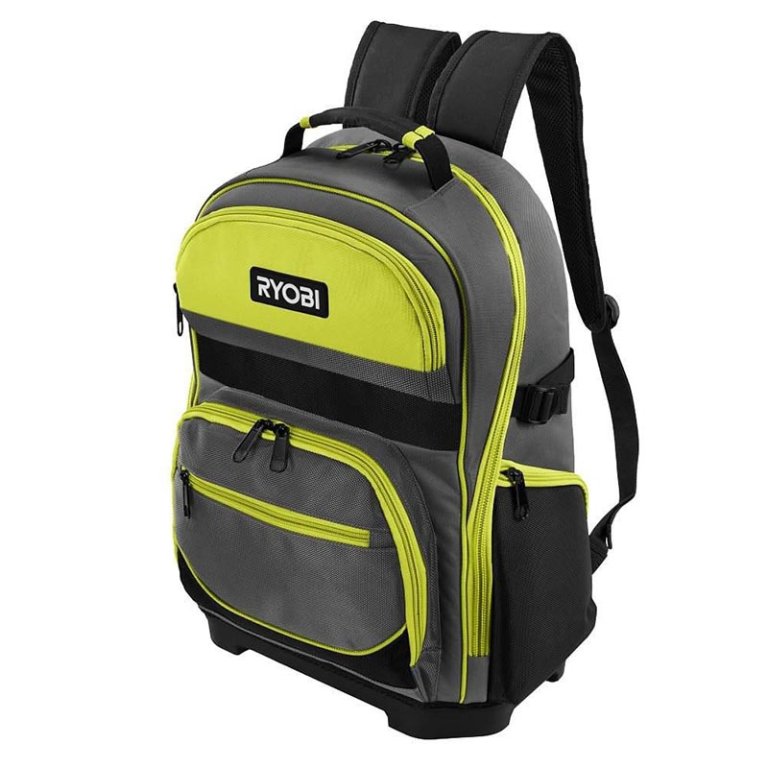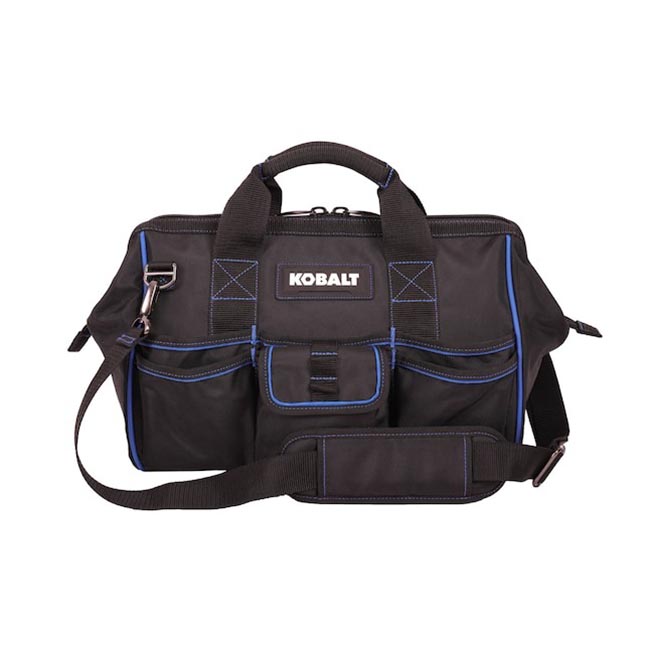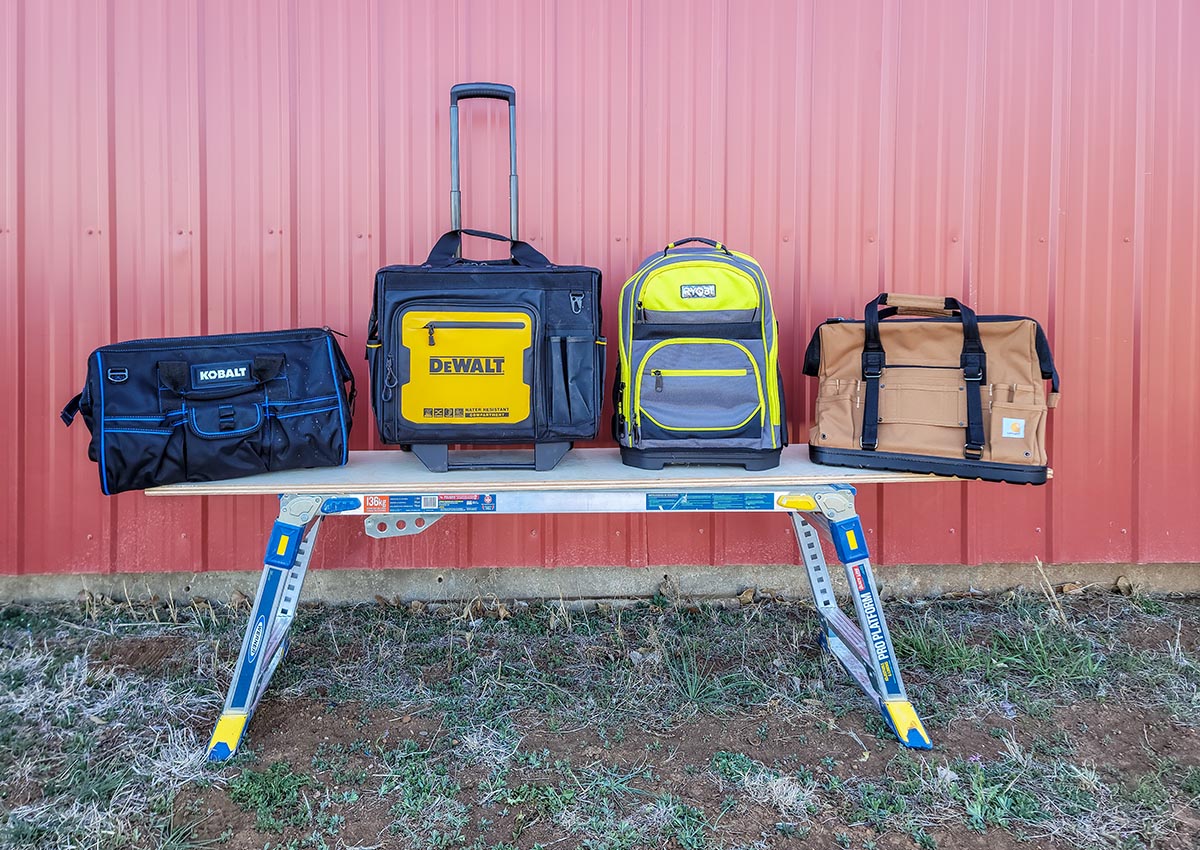
We may earn revenue from the products available on this page and participate in affiliate programs. Learn More ›
There comes a point when collecting a complete DIY set of tools starts causing storage issues, and that’s where tool bags come in handy. Tool boxes might do the trick as well, but they definitely have their shortcomings. Although they’re tough, tool boxes are so prone to disorganization that the bottom can easily become a black hole of screwdrivers, hammers, and other common go-to tools.
Tool bags, on the other hand, are designed to provide as much organization as possible while being lightweight for easy toting. We’re always looking for tools and accessories that help our readers, so we researched and tested several of the most popular tool bags to determine which ones are best suited for stowing different types of tools.
When shopping for a tool bag, John Lin, professional mechanic and cofounder of JB Motor Works in Philadelphia, Pennsylvania, recommends looking for a sturdy base. “Having a tool bag with a sturdy waterproof base isn’t just about durability but also about cleanliness, as it prevents dirt and grime from construction sites from entering your vehicle or workspace.”
Keep reading to learn how to tell the difference between a good tool bag and a great one. And find out how the following models fared in our hands-on tests to ultimately earn a spot in this lineup of the best tool bags.
- BEST OVERALL: CLC 18-Inch Multi-Compartment Tool Carrier
- RUNNER-UP: Carhartt Legacy 14-Inch Tool Bag
- BEST BANG FOR THE BUCK: WorkPro 16-Inch Wide-Mouth Tool Bag With Molded Base
- UPGRADE PICK: Husky 18-Inch 18-Pocket Rolling Tool Bag
- BEST FOR POWER TOOLS: Dickies 20-Inch Work Bag
- BEST FOR LARGE HAND TOOLS: Klein Tools 16-Inch Canvas Tool Bag
- BEST ROLLING: DeWalt 18-Inch Rolling Tool Bag
- BEST MOLDED BASE: Carhartt Legacy 18-inch Tool Bag With Molded Base
- BEST BACKPACK-STYLE: Ryobi 16-Inch Backpack With Tool Organizer
- BEST CARGO-STYLE: Kobalt KB 18-Inch Cargo Bag
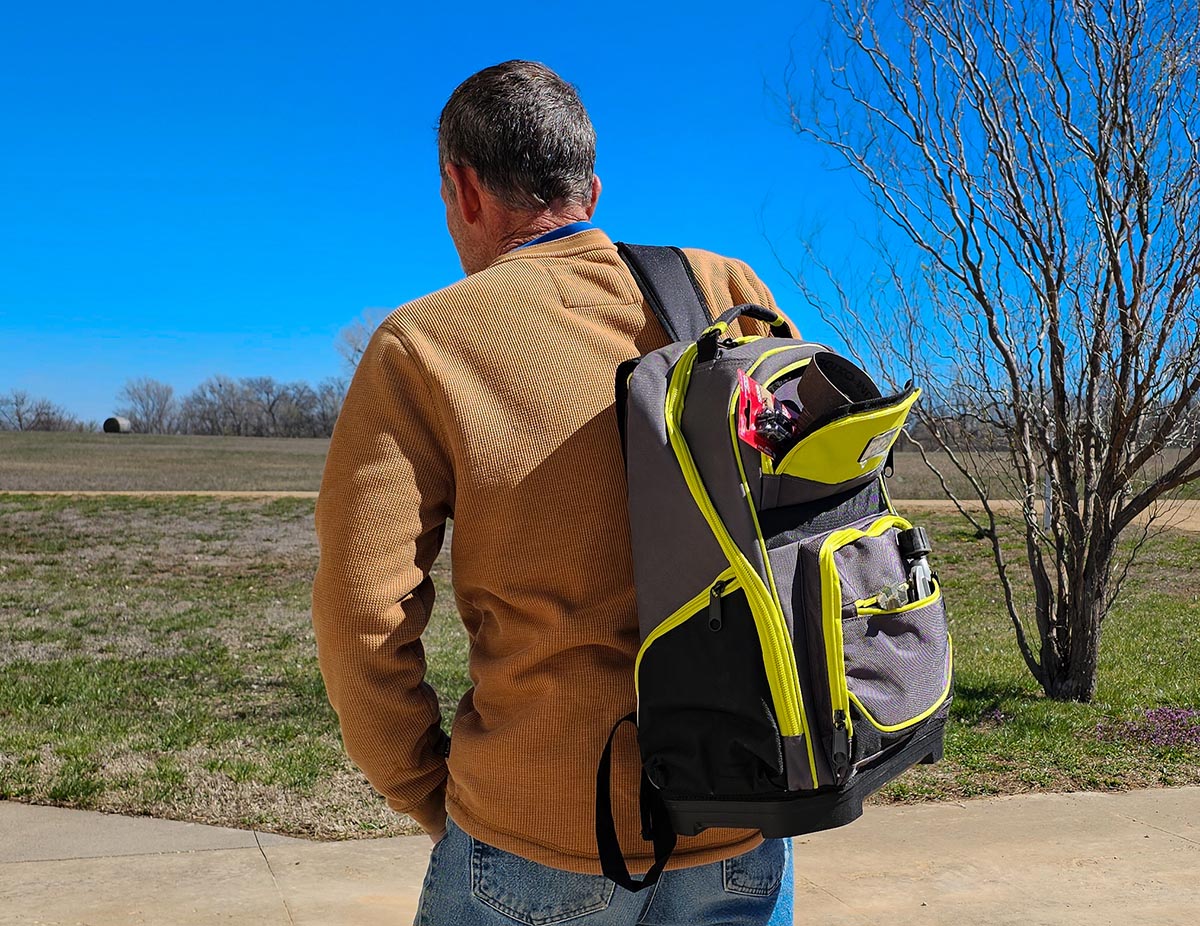
How We Tested the Best Tool Bags
We researched more than 35 different tool bags before choosing the ones we wanted to test in real-world settings. To decide which ones we would test, we took brand names into account to an extent; after all, brands like DeWalt, Carhartt, and Ryobi have a reputation for producing top-notch tools and accessories. Still, we didn’t automatically exclude smaller manufacturers or niche brands if their products boasted overwhelming customer satisfaction.
After finalizing our testing pool, we compiled a kit of basic DIY tools, including several sets of pliers, hammers, screwdrivers, drills, tape measures, marking tools, and other odds and ends. We filled each bag with the tools and put them through their paces.
We assessed how easy the bags were to organize and noted the ease of carrying each fully loaded bag. We also inspected the bags to assess their craftsmanship and durability. Each bag was awarded points based on a rubric: The better the bag performed on a test, the higher the points. After testing, we averaged the points to determine the best overall performers and to categorize the bags to each one’s best use cases.
Testing Stats
- Products tested: 10
- Hours spent testing: 20+
- Tests performed: 4
- Price range: $25 to $130
Our Top Picks
The following roundup is here to help readers select the best tool bag for their needs. It consists of some of the most popular options on the market, each of which we tested ourselves. Below our lineup, you’ll find shopping considerations when selecting a tool bag.
Best Overall
CLC 18-Inch Multi-Compartment Tool Carrier
What We Like
- Very high-quality nylon for long-term use and durability
- Impressive amount of storage; comes with a bevy of storage compartments, inside and out
- Best shoulder strap in the group; comes padded and completely adjustable
- Almost all storage is zippered to keep components safe and in place
What We Don’t Like
- May be overkill for users with more modestly sized tool collections
- Bottom isn’t waterproof; may not be ideal for rainy weather or outdoor work
Product Specs
- Size: 18 inches long by 7 inches wide by 14 inches high
- Weight: 6 pounds
- Number of compartments: 50
This Bob Vila Approved product carries our brand’s highest level of recommendation.

Bob Vila Approved recognizes the household and DIY products that impressed us most in our real-world testing and that exemplify core values of the Bob Vila brand, including craftsmanship, innovation, and value for the dollar. Winners of this designation come recommended by our professional review team and are personally approved by Bob Vila.
Our Ratings: Organization 5/5; Ease of Use 5/5; Durability 5/5; Water Resistance 3/5; Value 5/5
Any DIYer who has a lot of hand tools and needs a serious storage solution will want to check out this bag from CLC. This 18-inch carrier offers every tool a home while prioritizing organization. It has a zippered flap on either side that opens to reveal tons of pockets, plus a center pocket large enough to stash a few power tools at once. Everything zips away for secure storage.
This tool bag can be carried in two different ways: by grabbing the rolled and padded nylon handles or by using the shoulder strap, which features a cushioned pad and swivel hardware to keep it from tangling. We used it both ways in our testing, and they both served us very well. We also loaded all the tools in the test kit into the bag and still had an entire side of the bag left to fill, meaning this bag could have held twice as much without sacrificing organization.
One thing to note, though, is that the bag’s bottom isn’t waterproof, though it does feature sewed-on plastic feet.
Get the CLC tool bag at Amazon.
Runner-Up
Carhartt Legacy 14-Inch Tool Bag
What We Like
- Comfortable handles make this option easy to hold for long periods
- Durable enough to hold chisels, screwdrivers, and other sharp tools
- Framed opening allows it to stay open on its own; suitable for those who need to reach into their bag frequently
What We Don’t Like
- No zippered or buttoned pockets; may not be as reliable as some comparable options
- Only 1 pocket can fit a standard-size tape measure
- Lack of shoulder strap may not be ideal for some users’ preferences
Product Specs
- Size: 14 inches long by 9 inches wide by 10.5 inches high
- Weight: 2 pounds
- Number of compartments: 27
Our Ratings: Organization 4.5/5; Ease of Use 4.5/5; Durability 4.5/5; Water Resistance 4/5; Value 4.5/5
DIYers and pros alike will likely appreciate this durable bag from Carhartt. This 14-inch tool bag features a heavy-duty 1200-denier polyester construction and padded handles that are comfortable even while the bag is carried at full capacity. This bag has 26 tool pockets plus the main compartment, offering plenty of storage for hand tools and a power drill.
When testing the Legacy, a few features stood out. The material itself appeared to be very durable, and we didn’t feel wary of placing chisels inside some of the smaller side pockets. Also, the compact design allowed for plenty of storage without taking up too much space. We liked that the bag stayed open on its own and that the carrying handles were very comfortable.
The main downsides of this bag are that it lacks a shoulder strap—though the handles truly are comfortable—and there are no zippered pockets for smaller items.
Get the Carhartt 14-inch tool bag at Amazon or Carhartt.
Best Bang for the Buck
WorkPro 16-Inch Wide-Mouth Tool Bag With Molded Base
What We Like
- Waterproof bottom provides peace of mind when working outside
- Padded shoulder strap is comfortable and adjustable for ease of use
- Easy-access compartments for writing utensils or frequently used tools on the outside of the bag
- Great price point compared to other options on the market
What We Don’t Like
- Flimsy pull tabs may not be ideal for some users’ preferences
- Internal pockets are oddly shaped; may not fit some tools
Product Specs
- Size: 15.75 inches long by 8.66 inches wide by 9.84 inches high
- Weight: 12.3 ounces
- Number of compartments: 21
Our Ratings: Organization 4/5; Ease of Use 4/5; Durability 4/5; Water Resistance 5/5; Value 5/5
Homeowners and DIYers who need a small, lightweight bag to keep their gear in place without a bloated price tag will want to check out this budget-friendly tool bag from WorkPro. Compact in design, the bag features a polyester construction, a waterproof plastic base for extended durability, two hook-and-loop handles, and a padded shoulder strap. The bag offers two zipper pulls, which, when positioned in the middle of the zipper, make for easy one-handed opening.
Tests revealed that the shoulder strap was comfortable and certainly the best method for carrying this bag. We also liked the waterproof bottom and the obvious storage for writing utensils, a detail many tool bags lack. There are 21 spots for storing tools, but the internal pockets are oddly shaped, so secure storage might be an issue. The material is lower quality than the other bags on the list, but the price reflects that; overall, it’s a good value.
Get the WorkPro tool bag at Amazon.
Upgrade Pick
Husky 18-Inch 18-Pocket Rolling Tool Bag
What We Like
- Most versatile handles in the group; comes with carrying handles and a telescoping handle
- Pockets are deep enough to hold large and small tools and accessories
- Velcro closure in front is perfect for driver bits and small odds and ends
- Wheels roll well over rough terrain; suitable for both indoor and outdoor jobsites
What We Don’t Like
- Pockets are not specific for any tools; may not suit the needs of some users
- May become too heavy if loaded to its full capacity
- No side handles or shoulder strap for lifting and carrying long-term
Product Specs
- Size: 18 inches long by 9 inches wide by 17 inches high
- Weight: 11.85 pounds
- Number of compartments: 18
Our Ratings: Organization 4/5; Ease of Use 3.5/5; Durability 5/5; Water Resistance 4.5/5; Value 4/5
Anyone with a heap of tools to transport can give their back a rest with this rolling tool bag from Husky. This bag features 600-denier polyester fabric, a telescoping handle, and a set of wheels that roll well even across rough, uneven surfaces. The high-quality construction and thoughtful design are standout features, as is the bag’s 100-pound weight capacity.
The Husky is really a premium product. We liked the 18 well-designed pockets, one of which features a hook-and-loop closure that’s suitable for smaller items like driver and drill bits. We also found that the two padded handles were the most comfortable in our test group—even despite the nearly 12-pound unloaded weight of the bag. The large main compartment held lots of tools during testing—we even snuck an extra circular saw in for good measure. Also, the telescoping handle worked flawlessly with one hand, and the wheels were smooth and rugged.
The one problem? There are no side-mounted handles to make lifting it in and out of a vehicle easier.
Get the Husky tool bag at The Home Depot, Amazon, or DK Hardware.
Best for Power Tools
Dickies 20-Inch Work Bag
What We Like
- Billowed pockets with webbing hold lots of items securely
- Comfortable to carry; comes with carrying handles and a shoulder strap
- Tons of storage; features 14 pockets and a large internal space for larger tools
What We Don’t Like
- Zipper sticks from time to time; may not be ideal for some users
- Shoulder strap is comfortable but material isn’t high quality
- Interior pockets aren’t billowed and are all the same size
Product Specs
- Size: 22.5 inches long by 12 inches wide by 12.25 inches high
- Weight: 2.77 pounds
- Number of compartments: 15
Our Ratings: Organization 4/5; Ease of Use 4/5; Durability 5/5; Water Resistance 4/5; Value 4.5/5
Haul everything, regardless of weight, with the Dickies 20-Inch work bag. Built from durable canvas with a polyester interior lining to be strong and lightweight, it boasts a huge center compartment that will accommodate a drill, reciprocating saw, circular saw, and even a few batteries. There are eight external compartments and six interior pockets suitable for both small tools and larger hardware.
This bag produced impressive results in our testing. Long and deep, the center compartment held large hand tools well and offered room for power tools and DIY products, too. Also, the pockets feature a billowed design with a strap of strong webbing at the top, offering lots of secure storage. This bag was comfortable to carry, even when it was fully loaded. We didn’t like that the zipper was a little sticky while attempting to open it one-handed, and the pockets seemed too general in size, but overall, it’s a great bag.
Get the Dickies tool bag at Amazon.
Best for Large Hand Tools
Klein Tools 16-Inch Canvas Tool Bag
What We Like
- Made of rugged canvas and durable leather handles and buckles for long-term durability
- Abrasion-resistant leather reinforced bottom; suitable for indoor and outdoor use
- Heavy-duty hinged metal opening helps keep the bag open during projects
What We Don’t Like
- Lacks organization compartments; no pockets integrated into the design
- The handles are comfortable but a little slippery
Product Specs
- Size: 16 inches long by 6 inches wide by 14 inches high
- Weight: 3 pounds
- Number of compartments: 1
Our Ratings: Organization 3.5/5; Ease of Use 5/5; Durability 5/5; Water Resistance 4/5; Value 4.5/5
This pick from Klein Tools is a classic take on the modern tool bag. It features a durable canvas construction that’s resistant to tearing as well as natural leather handles that are rolled and stitched for maximum comfort. Also, the thick leather straps and metal buckle ensure that this bag stays shut.
Testing proved what we already suspected: quality was top-tier, while organization was lacking. We appreciated the heavy-duty hinged metal opening as well as the incredibly durable canvas and vegetable-tanned leather handles and buckles. We liked that Klein stitches abrasion-resistant leather over the bottom of the one-piece canvas bag instead of just stitching the bag’s walls to a piece of leather for improved strength.
Do note that there are no pockets, so it’s best for stowing large hand tools or inserting plastic organizers.
Get the Klein Tools tool bag at Amazon or The Home Depot.
Best Rolling
DeWalt 18-Inch Rolling Tool Bag
What We Like
- Durable construction; the bag is made with quality materials and double-stitched seams
- Molded plastic base helps prevent water from seeping through when setting the bag on damp grass
- Wide zip-open top makes it easy to see the bag’s contents
- Wheels and handle add a measure of portability, making it easier to transport heavy items
What We Don’t Like
- Lack of fold-over flaps on exterior pockets reduces the bag’s protection from rain
Product Specs
- Size: 19.25 inches long by 12.13 inches wide by 18.25 inches high
- Weight: 8.84 pounds
- Number of compartments: 28
Our Ratings: Organization 5/5; Ease of Use 4/5; Durability 5/5; Water Resistance 4/5; Value 5/5
DeWalt doesn’t just know tools—they also know the best ways to store them. We’re longtime fans of the brand, and their 18-inch rolling tool bag reinforced our dedication. We’re familiar with DeWalt tool boxes, and this bag combines the best of a tool box and a tool bag.
To begin our testing, we loaded up the bag with several tools and accessories. We really liked the molded plastic base, which is designed to prevent water from seeping through the fabric if it’s set in a damp location. Another nice feature of the DeWalt tool bag is its wide zip-open top, which opens completely so that the user can see everything in the bag at a glance.
The bag features 28 compartments, and we found a nice assortment of small pockets inside for storing items we wanted to protect from moisture. The additional pockets on the outside were great for tools that could withstand light rain. The bag has two exterior zipper compartments, one of which was just the right size to stow our cell phone.
We found this to be a great all-around work bag, and we felt it was well suited for particular DIY tasks, such as organizing and storing a collection of wiring tools and accessories. The wheels and extendable handle made it super portable when carrying heavy items. The only thing we would have liked was a few fold-over pockets on some of the outside compartments to make the bag slightly more protective in rainy conditions.
Get the DeWalt tool bag at Amazon, Lowe’s, or Ace Hardware.
Best Molded Base
Carhartt Legacy 18-inch Tool Bag With Molded Base
What We Like
- Plenty of storage with 45 compartments; perfect for a large collection of small tools
- Relatively compact bag; easy to carry with side straps or shoulder strap
- Custom-molded base keeps the bag from absorbing water if set down on damp grass
What We Don’t Like
- Exterior storage pockets are open at the top, so there’s no protection from rain
Product Specs
- Size: 18 inches long by 13.5 inches wide by 11.5 inches high
- Weight: 5.34 pounds
- Number of compartments: 45
Our Ratings: Organization 5/5; Ease of Use 5/5; Durability 4/5; Water Resistance 5/5; Value 5/5
If you have a large collection of smaller tools, such as screwdrivers and pliers, the Carhartt tool bag might be the right solution for you thanks to its impressive inclusion of 45 compartments. The bag is relatively compact, but we were still able to store a few power hand tools in the large inner compartment and a plethora of smaller tools in the bevy of interior and exterior pockets.
Carhartt didn’t skimp on pockets with this tool bag. The exterior features pockets layered over existing pockets, which increases storage space and makes organizing easier.
We loaded the bag and carried it using its side handles as well as the optional adjustable shoulder strap. Both worked well, but we preferred removing the shoulder strap because we found it handier to pick it up by the side handles for quick transport. The custom-molded abrasion-resistant base is great when setting the bag on damp grass.
The tool bag’s canvas exterior is water-repellent but only protects the items in the large interior compartment when zipped. The open pockets on the outside will take on water and hold it, so keep this bag out of the rain. In addition to being a great tool bag, it would be a good pick for an artist or craftsperson who wants to store several small tools.
Get the Carhartt 18-inch tool bag at Amazon, The Home Depot, or Carhartt.
Best Backpack-Style
Ryobi 16-Inch Backpack With Tool Organizer
What We Like
- Backpack-style design is ideal for carrying items over longer distances
- Plenty of organizational storage with 31 compartments (including laptop compartment)
- Zippers on exterior pockets add water resistance and security for items
What We Don’t Like
- Molded plastic base may be uncomfortable for some users during backpack carry
Product Specs
- Size: 16 inches long by 8 inches wide by 20 inches high
- Weight: Not listed
- Number of compartments: 31
Our Ratings: Organization 4/5; Ease of Use 5/5; Durability 4/5; Water Resistance 5/5; Value 5/5
A backpack is an optimal solution if you need to carry items over a distance. This backpack from Ryobi looks like many other types of backpacks, but it features 31 compartments to organize tools and accessories.
What we liked most about the Ryobi backpack were the zippers on the exterior compartments. With no open pockets for rain to get it, this backpack-style tool bag will keep your possessions dry if you get caught in a light rain. We loaded it up and set it in the path of a sprinkler for 10 minutes to see if it was really water-resistant. When we opened the backpack, we found all the items we’d stowed inside were still dry—except for one pocket where we hadn’t closed the zipper completely. Our bad.
The manufacturer doesn’t list a weight limit for the bag, but we found it held 30 pounds without straining the seams or the zippers. Ultimately, a person’s physical strength and the distance you will carry the bag will determine the best weight limit. The only thing that could be improved is the molded plastic base. While it’s great for those times you need to set the bag on damp grass, it poked into our hips when we carried it as a backpack.
After unloading all the tools we used to test it, we put our DSLR cameras inside and filled the interior and exterior pockets with our lenses, flashes, and filters. All went well. Ryobi designed this tool bag to carry small power tools and accessories, but it’s suitable for other items, too.
Get the Ryobi tool bag at The Home Depot or Walmart.
Best Cargo-Style
Kobalt KB 18-Inch Cargo Bag
What We Like
- Sturdy; capable of holding several hand tools and smaller accessories
- Top of bag opens completely, making it easy to see and retrieve stored items
- Users can carry the Kobalt bag with its side straps or with the removable shoulder strap
What We Don’t Like
- Does not feature a waterproof base, although the fabric is water-resistant
Product Specs
- Size: 18 inches long by 8.5 inches wide by 12 inches high
- Weight: Not listed
- Number of compartments: 19
Our Ratings: Organization 5/5; Ease of Use 5/5; Durability 4/5; Water Resistance 5/5; Value 5/5
Lowe’s has a winner with this handy Kobalt tool bag. It doesn’t come with many bells and whistles, but it’s rugged, well designed, and capable of holding several hand tools and many smaller accessories.
We loaded up the Kobalt bag with some drills, screwdrivers, portable work lights, and other small accessories. The top of the bag has a zipper closure, and we liked the ability to open both sides all the way so that we could easily see and retrieve tools from the inner compartment.
The bag comes with side handles and an optional shoulder strap. We found both suitable (and comfortable) for carrying our gear, but we preferred the handles, so eventually, we removed the shoulder strap. The manufacturer doesn’t list a maximum weight limit, but we loaded about 35 pounds in the bag and didn’t notice any bulging seams or tears.
With the bag’s 12 pockets on the exterior and six inside, we had plenty of room to hold DIY tools, screws, nails, and the like. We did run into one small issue that we feel was a fluke: A Velcro-type pocket flap on the outside of the bag was missing one of its Velcro pads.
The Kobalt tool bag’s size and design would make it ideal for carrying a socket set, wiring tools, or other small-project tool collection.
Get the Kobalt tool bag at Lowe’s.
Jump to Our Top Picks
What to Consider When Choosing a Tool Bag
Choosing the best tool bag might seem simple, but there are a few points to consider before dropping cash on any old bag. The following sections include some of the most essential considerations to remember when shopping for the best tool bag, from storage to material and more.
Number of Storage Pockets
If you have a lot of small hand tools, meters, and gadgets, you probably don’t want them all piled up at the bottom of a tool bag. For DIYers, the more pockets, the merrier—and the less messy. The best tool bags have plenty of storage options for keeping gear stowed away properly and safely, leading to a more efficient workflow and better results.
Framed Opening
Often, on a jobsite, one’s workflow may require reaching for a tool or putting one away with one hand. A tool bag with a floppy opening will make this challenging, if not impossible. To bypass this frustration, look for a tool bag with a wire or metal frame reinforcing the opening of the main compartment. This allows for one-handed opening and closing.
If that doesn’t seem important, consider how much money a quality tool set costs to assemble. Without that structured opening, those expensive tools tend to lay on the ground where they can become bent or even ruined. A tool bag with a framed opening can save time and money by preventing this.
Material Quality
According to Terry Dussault, CEO of Yellowknife Safety in Huntington Beach, California, shoppers may want to look for “a tool bag made from sturdy materials like heavy-duty fabric or reinforced nylon to withstand the wear and tear of projects.” Dussault also recommends a tool bag with water-resistant or waterproof material to protect your tools from rain or accidental spills.
The most common materials for tool bags are thick nylon, canvas, and polyester. These materials can support plenty of weight, and sharp tools won’t poke through their sides. Rubber makes a top-notch base for a tool bag due to its durability and nonslip attributes. Inexpensive bags made of cheaper materials like faux leather and low-grade nylon are bound to rip prematurely and cost more in the long run when it comes time to replace them.
Zippers and Buckles
There’s no sense organizing a tool bag if everything falls out of it in the truck or backseat. These bags are meant to be closed and secured, so make sure any bag you choose uses a high-quality zipper or buckle system. Look for large nylon zippers with pull tabs that operate with a gloved hand. As for buckles, look for traditional bags with metal buckles and leather straps, which will hold up well over time. If you prefer lightweight buckles, go for durable nylon over plastic.
Size and Intended Use
Tool bags come in all shapes, sizes, and styles. Some are tailored toward particular trades, while others are general catchalls. Sizes can vary from 14 to 24 inches in length. Due to this wide range of sizes and designs, it’s important to consider the type of use the bag will likely see before buying one.
If it’s headed to a jobsite everyday with many large, heavy tools, a 14-inch or 16-inch bag with a 50-pocket main compartment won’t be much good; a 20-inch or 24-inch bag with fewer pockets and ample room for large tools would do better. Conversely, if the tool bag serves as a caddy for carrying tools from the garage to the house, consider a smaller bag with lots of storage pockets.
Carrying Options
The best tool bags have large handles with over-molded rubber grips, rolled nylon, or a leather sleeve. These are all comfortable options when hauling a heavily loaded bag for any distance.
For larger bags, look for shoulder straps with thick padding to keep them from digging into a shoulder. Avoid thin, flat straps that put a lot of pressure on a very small area; they’re sure to cause pain and fatigue. A thin strap without any padding will mean stopping often to switch grips as well, slowing the entire process down.
FAQs
Even with that extensive background on choosing the best tool bag, some additional questions might pop up. This section aims to answer those queries by addressing some of the most frequently asked questions about tool bags. Be sure to check for an answer to your question listed below.
The ideal size for a tool bag depends on the use. A 14-inch or 16-inch bag will do the trick for smaller hand tools and a drill. For larger power tools, a longer bag in the 20-inch range might be better.
The most important features to look for in a tool bag are durable materials and plenty of storage. Nylon, polyester, canvas, and leather are typically the best materials.
Most polyester and nylon bags will shed quite a bit of water before becoming soaked, though you could treat any bag with a fabric protector for weather resistance.
Meet the Testers
Glenda Taylor is a product tester and writer specializing in the construction, remodeling, and real estate industries. She and her husband own a general contracting company, and Taylor is experienced in both residential and commercial building applications. She tests a wide range of power tools as well as other home improvement, household, and lawn-and-garden products.
Tom Scalisi is a full-time DIY and construction writer for many of the largest websites in the industry, including BobVila.com, This Old House, Family Handyman, and Forbes as well as his own pest control blog.
